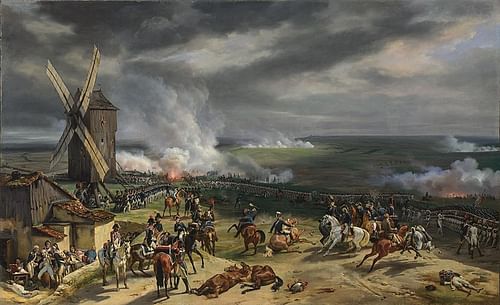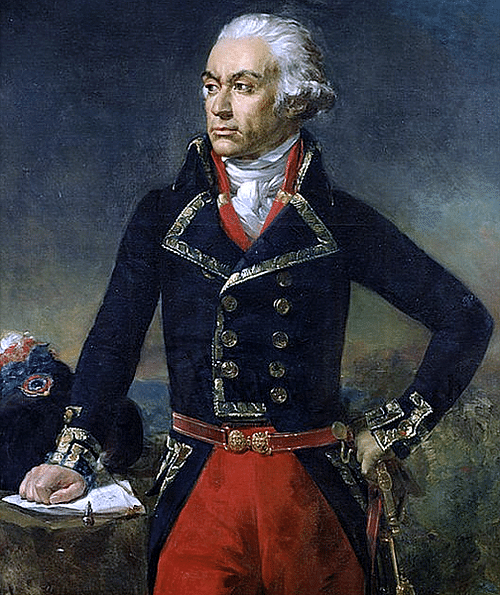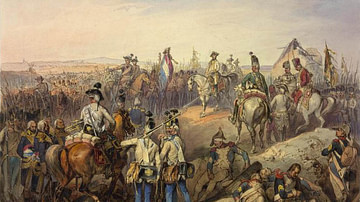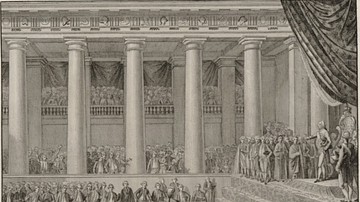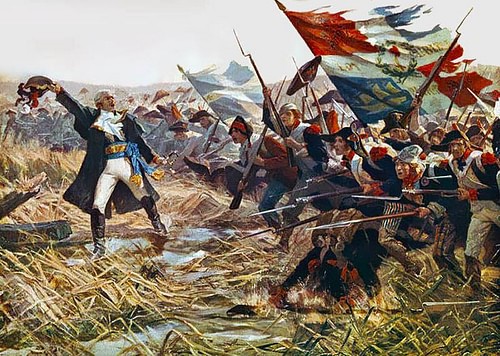
The Battle of Jemappes was a decisive battle in the War of the First Coalition (1792-97), part of the French Revolutionary Wars (1792-1802). On 6 November 1792, a French army under General Charles-François Dumouriez defeated an Austrian force on the heights of Jemappes in the Austrian Netherlands, leading to the French conquest of Belgium and the expansion of the war.
The battle was the first true test of the armies of the First French Republic (1792-1804), which had been born less than two months earlier. It secured the gains won by the French after the Battle of Valmy and emboldened the French to continue going on the offensive, confident in their 'universal crusade,' which sought to spread the principles of the French Revolution (1789-99).
Victors of Valmy
The Battle of Valmy, fought on 20 September 1792, was a stunning victory for the ragged armies of the French Revolution. Clustered around an old windmill, French artillery held the heights of Valmy against a half-hearted attack by dysentery-afflicted Prussians, advancing through rain and mud. The battle proved decisive, halting the Prussian invasion which had threatened to destroy Paris, and giving renewed energy to the Revolution. On 21 September, the day after Valmy, the National Convention was emboldened enough to abolish the monarchy and declare the French Republic. 22 September was proclaimed the first day of Year I of the Republic, marking the beginning of a new order. France's wartime fortunes were also reversed after Valmy, as reinvigorated French armies swept into both Savoy and the Rhineland.
In the immediate aftermath of the battle, however, it was not yet clear how decisive the day had been. As night fell over the rain-drenched battlefield, the victorious French under General François Christophe Kellermann (1735-1820) silently withdrew from the heights, knowing that they did not have the numbers to withstand a more spirited Prussian assault. They pulled back to the town of Sainte-Menehould, headquarters of the Army of the North, destroying roads and fields along the way to slow the expected Prussian advance. Yet, no such advance would be forthcoming. The Prussian army, ravaged by dysentery and a dwindling food supply, had become demoralized by the unexpected stiffness of French resolve; this would not be the swift and easy conquest promised by their French royalist allies. Prussian commander Charles William Ferdinand, Duke of Brunswick, proclaimed "hier schlagen wir nicht" ("we will not fight here") and decided to negotiate a retreat.
On 22 September, a certain Colonel Manstein was sent to treat with the commander of the French Army of the North, General Charles-François Dumouriez (1739-1823). A career soldier and occasional politician, Dumouriez had briefly served as French foreign minister from March to June 1792, having used that position to drum up support for the war against Austria. But to Dumouriez's mind, the war was against Austria alone, as the Austrian Habsburgs were deemed by many to be the true external threat to French liberty. Prussia's entry into the conflict as Austria's ally had been an unfortunate development, one that Dumouriez had worked hard as foreign minister to avoid. Eager to get back to fighting the Austrians, Dumouriez found that an opportunity had landed in his lap to remove the Prussians from the war altogether.
Negotiating Peace
Dumouriez greeted Colonel Manstein warmly, lamenting that he had to fight Prussia and praising the legacy of the late King Frederick II the Great (r. 1740-1786). He reminded the envoy that France had declared war on Austria, not Prussia, which meant that peace could easily be procured. All the Prussians had to do was retreat across the frontier and stay there, as well as disavow their alliance with Austria, which Dumouriez referred to as unnatural and disadvantageous to the Prussians. As Austria and Prussia were traditional rivals, Dumouriez pointed out that Austria would not miss an opportunity to weaken Prussia under the guise of friendship, as he believed they had previously done to France.
Manstein agreed that the Prussians had never desired war and did not wish to continue it. He allowed that peace could be obtained on one condition: King Louis XVI of France (r. 1774-1792) and his family must be freed from their captivity and restored to the powers allotted to them under the French constitution of 1791. This gave the French general pause; reluctantly, he explained that this would be impossible, as France had declared itself a republic the day before. Horrified, Colonel Manstein stormed from the French camp without another word. Over the following days, Dumouriez continued to try and make peace with the Prussians, continuing to emphasize that France's quarrel was with Austria alone, and even sending coffee and sugar to their camp as a show of good faith.
Yet despite Dumouriez's desperate entreaties, it was the Prussians, not the French, who were running out of time. Every day their army grew weaker, as the French ranks swelled with reinforcements. After a week, Brunswick sent Colonel Manstein back to Dumouriez with a counteroffer: if the French could guarantee the personal safety of their royal family, and if Dumouriez pledged not to harass the Prussian retreat, then they would withdraw past the frontier. Knowing it was not within his powers to guarantee the former king's safety, Dumouriez did so anyway. On 30 September, the Prussians struck camp and began their slow and humiliating retreat.
Dumouriez sent Kellermann's Army of the Center to act as a convoy, shadowing the Prussian army to ensure it stuck to its word. The Prussian retreat was difficult. During their initial invasion, the Prussians had spread disease to every village they passed through. Now, these villagers wanted revenge. Angry French peasants harried the Prussian retreat, burning and pillaging baggage carts and murdering soldiers who were unfortunate enough to stray from the main columns. On 23 October, Brunswick's army finally crossed back into Germany, at which point Kellermann fired off three salvos from the same cannons that had proved so effective at Valmy, a signal that France was free from invaders at last.
Invading Belgium
Dumouriez was now free to turn his attention to the Austrians, and to the place where he believed he could beat them: Belgium, then known as the Austrian Netherlands. In 1789, the Belgians had revolted against Habsburg rule in the short-lived Brabant Revolution. Although the rebellion had since been put down, Dumouriez believed the presence of France's revolutionary armies would incite the Belgians to rebel again, thus helping turn the tide of war. Obsessed with the prospect of a Belgian invasion, Dumouriez had been planning his campaign since before the declaration of war. Now, he could put it into action.
In early October, he sent his army off to Valenciennes to prepare, while he himself returned to Paris to gather funds and support for his plan. He arrived on 11 October, where he was applauded by the National Convention and leaders of the Girondin faction; famed actor François-Joseph Talma even put on a special performance in his honor. Yet, his return was met with skepticism from the Jacobin faction, who doubted his intentions. Jacobin leader Maximilien Robespierre (1758-1794), who had long made clear his distrust of the generals, warned that Dumouriez meant to turn Belgium into his own private fiefdom, from whence he would march on Paris. Other Jacobins noted the general's monarchist sympathies and connected him with supposed counter-revolutionary Girondin plots.
But despite Jacobin skepticism, Dumouriez was able to obtain the men, money, and material he needed, for one reason in particular: the depreciating value of the assignat, France's new currency. With inflation rising, the National Convention realized it could barely afford to feed its soldiers, and believed it would be expedient for its armies to go on the offensive in enemy territories, where they could live off the land. Furthermore, Dumouriez promised to deliver any plunder his army captured while campaigning in Belgium directly to the French treasury.
Against the backdrop of other successful French offensives in Savoy and the Rhineland, it appeared advantageous to let Dumouriez have his pet project. Additionally, some French leaders were quite pleased with the thought of a liberated Belgium serving as a buffer state between France and its enemies. So, having received the support he desired, Dumouriez left Paris on 15 October and rushed back to his army. Despite the misgivings of his officers regarding the discipline of their men, Dumouriez set out with confidence, "as if he were leading the finest troops in the world" (Phipps, 140).
Opposing Forces
Dumouriez commenced his campaign with roughly 40,000 men and 100 guns. He first advanced toward the French town of Lille, on the border with Belgium, which was being besieged by 20,000 Austrians under the command of Albert Casimir, Duke of Saxe-Teschen, governor of the Austrian Netherlands. Upon hearing of the French approach, Saxe-Teschen broke off the siege and crossed back into Belgium. Forced to spread his troops thinly, he entrenched 13,700 of his men on the heights of Jemappes, in front of the city of Mons. Although the Austrians possessed the high ground and around 56 guns, their situation was dire; the Austrian government's preoccupation with events in the east, such as the second partition of Poland, meant that it could spare few troops to reinforce Belgium.
On 27 October, a 10,000-man French column under General François d'Harville arrived before Jemappes, skirmishing with Austrian scouts. By 5 November, the rest of Dumouriez's army had drawn itself up in front of the Austrian defensive line, parallel to the village. Despite the Austrians' strong positions, Dumouriez thought it prudent to attack here, lest he allow the Austrians to slip away. This was undoubtedly a risky move; unlike Valmy, where Kellermann's troops consisted mainly of regulars, Dumouriez led an army of volunteers, enthusiastic but undisciplined, yet to be tempered in battle. Therefore, it was at Jemappes, rather than at Valmy, where the French revolutionary army would truly be tested.
Dumouriez's plan was to turn both of the Austrian flanks. He divided his army into two wings: the right, under General Pierre de Beurnonville, would attack first, sweeping around the Austrians' left flank where they were weakest and pushing on toward the center. The French left wing, under General Jean Becays Ferrand was to attack the village of Quareignon, while reserve troops under d'Harville were to reinforce the right before moving to cut off the Austrian retreat. The young Louis-Philippe, Duke of Chartres, would maintain command of the French center. With his generals in agreement, Dumouriez planned his attack for the next morning.
Battle of Jemappes
At 8 am on 6 November 1792, the peaceful silence hanging above Jemappes was broken by the thunderous roar of French artillery. As at Valmy, the professional French batteries would prove highly effective. Yet unlike at Valmy, the French were on the attack; they could not drive the Austrians from the heights with artillery alone. In tandem with the artillery bombardment, Dumouriez ordered the infantry assault, beginning with General Beurnonville's right wing. Due to poor communication, Beurnonville's attack was delayed, and once it began, it proceeded at a slow pace. This allowed the Austrians time to reinforce their weak left flank and to concentrate their own artillery fire on Beurnonville's men. This effectively pinned Beurnonville down, grinding his attack to a halt.
On the French left wing, things went no smoother. As ordered, General Ferrand approached Quareignon. However, rather than take the village, Ferrand wasted time by uselessly shelling it. Frustrated, Dumouriez sent a colonel named Thouvenot to relieve Ferrand, who had "lost his senses", from command, ordering Thouvenot not to return until he was "master…of the village" (Dumouriez, 335). After taking control of Ferrand's men, Thouvenot successfully assaulted the village and drove out the Austrians fortified there.

By now, it was noon, and the momentum Dumouriez had been relying on was lost. With Beurnonville still pinned down, he decided to order a new assault, this time from the center. Led by the Duke of Chartres, the French advanced across the plain toward the ridge, sustaining enemy fire. As they drew nearer, the fire grew more intense, both from muskets and grapeshot, which shredded through the French ranks. Panicking, many began to run; an Austrian cavalry charge broke much of the rest. Yet, in this pivotal moment, the day was saved by Chartres, who rode amongst the fleeing men, rallying them. He gathered many of them around him, reorganizing them into a large, mixed unit which he dubbed, "the battalion of Jemappes" (Phipps, 143), and the battalion followed Chartres back into the fray, charging into the Austrian redoubts. This time, Chartres' men held firm, establishing a foothold in the Austrian line. Every attempt to dislodge them failed.
Meanwhile, Colonel Thouvenot positioned his men along the right side of Quareignon and opened fire on the exposed Austrian right flank, which was now sandwiched between his and Chartres' men. Soon, the Austrian center and right began to crumble, leaving only the left flank, where Beurnonville's men were still pinned down. But amidst the confusion of Chartres' assault, two of Beurnonville's brigades managed to move forward under heavy fire and were able to finally make it to the enemy fortifications. Storming the Austrian defenses, they engaged the Hungarian grenadiers positioned there in brutal hand-to-hand fighting.
The cannons positioned atop the redoubts stopped firing at the rest of Beurnonville's men and turned toward the brigades who had breached their lines, allowing the other French a chance to rush forward. Eventually, these men were reinforced by General d'Harville, and the Hungarians were routed. Soon enough, General Dumouriez himself rode up to personally take command of these men, leading them along the back of the ridge as they sang La Marseillaise. The remaining Austrians withdrew to the city of Mons, leaving the heights of Jemappes to the French. The battle was over.
Liberators or Conquerors
The retreating Austrians left 4,000 of their men behind on the battlefield that night, either dead, wounded, or captured. By contrast, the French lost around 2,000 men. Having gathered the remnants of his army in Mons, the Duke of Saxe-Teschen realized he did not have the resources to hold out against the French. The next day, he slipped out of Mons, which was occupied by the French on 8 November. Within a week, the French were marching through the streets of Brussels, and by December, Dumouriez's invasion of Belgium was complete.
Coupled with the rapid conquests of Savoy and the Rhineland, Dumouriez’s conquest of Belgium vindicated the French in their idea of a 'universal crusade' to spread their revolution beyond France's borders. The National Convention issued an Edict of Fraternity on 19 November, which promised "fraternity and assistance" to all peoples who wished to recover their liberty, giving French generals free rein to help anyone being "persecuted for their attachment to the cause of liberty" (Blanning, 92).
This edict unnerved most of the rest of Europe, as the French were essentially advocating revolution and upheaval in any regime, not just in those of France's existing enemies. As the conquest of Belgium took France's armies to the border with the Dutch Republic, many believed that the French would use their Edict of Fraternity to justify an invasion of Holland. Although previously avowing a policy of neutrality, this turned Great Britain against the French, who warned them not to attack the Dutch. Still intoxicated by their victories at Valmy and Jemappes, the French Republic responded by declaring war on Britain and the Dutch Republic on 1 February 1793; not a single deputy in the French National Convention voted against this decision.
Yet even as France dug itself ever deeper into a continental war, the question remained: what would become of Belgium? Many had presumed it would be granted its independence, in accordance with Revolutionary France's promise to never be a wartime aggressor. But Dumouriez showed no signs of allowing Belgian independence, conducting his own foreign policy in Belgium without regard to the National Convention. To counter Dumouriez's insolence, the Convention passed a decree on 15 December that subjected conquered Belgium to France's revolutionary policies, destroying Belgium's feudal regime and confiscating church properties in the name of the state. Of course, this was a far cry from the self-determination the Belgians had been promised. Henceforth, the Declaration of the Rights of Man and of the Citizen would apply to all peoples conquered by the Republic.
Shortly after Jemappes, a cry went up for France to ensure its defense by gaining natural frontiers. "The French Republic should have no other frontier than the Rhine," wrote Jacques-Pierre Brissot to Dumouriez (Blanning, 91). At the end of the year, France annexed Savoy and Nice, terming it a 'reunion'. The line between 'liberation' and 'annexation' was quickly becoming blurred.
The French would not hold Belgium for long. On 18 March 1793, a Coalition army defeated Dumouriez at the Battle of Neerwinden, reasserting Austrian control over Belgium. Shortly after, Dumouriez and Chartres both defected. Still, the French victory at Jemappes helped secure the gains made at Valmy and ensured that the war would expand to an even greater scope.

